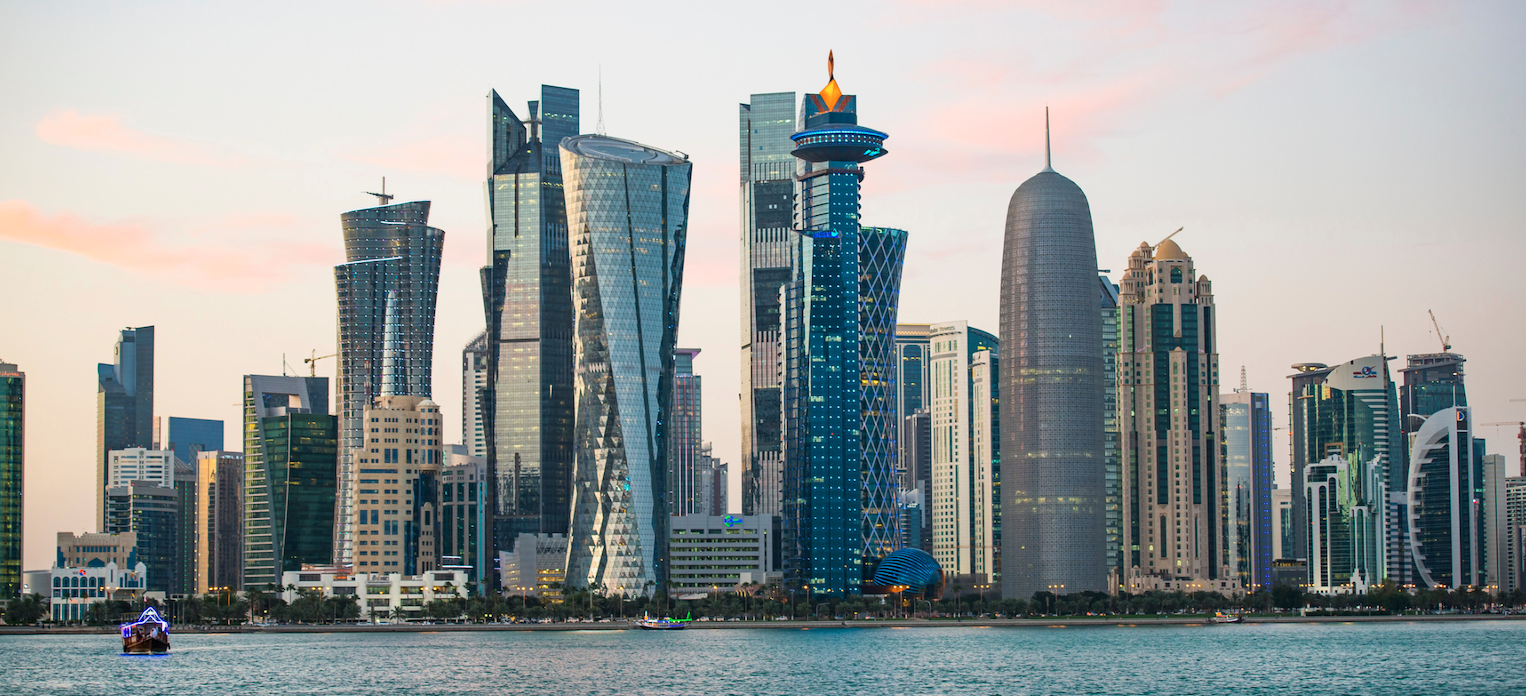With the FIFA World Cup kicking off in Qatar this week, it’s the perfect time to take a look at what’s happening in Qatar’s food and beverage market! At just under 3 million, Qatar’s population is relatively small compared to its Middle-Eastern neighbours. But don’t let this deter you from considering Qatar as an export destination, as it has plenty to offer! With that said, let’s take a look at the key sources of opportunity in this young, wealthy economy.
FIFA World Cup Boosting the Economy in 2022
It’s no secret that the pandemic limited economic growth prospects over the past two years around the world, and in Qatar. Coupled with a drop in oil prices, this saw the Qatar economy enter a downward trajectory, experiencing an economic decline of -3.7% over the past two years. Yet recovery is in sight, with Qatar’s hosting of the FIFA 2022 World Cup prompting higher than usual tourism flows and is set to provide a much-needed boost for the economy, especially the hospitality sector. Rebounding domestic demand and rising hydrocarbon prices will also support growth, which is expected to be near 4% before slowing down in 2023 and beyond as the situation normalises. Overall, Qatar is one of the most economically stable markets in the Gulf region with a highly attractive consumer market, improving the opportunities available for exporters.
A Friendly Bilateral Relationship with Australia
Now, what does Australia’s relationship with Qatar look like? Qatar and Australia maintain a strong bilateral relationship, cemented by commercial links, primarily food exports, such as lamb, beef, poultry and cereal, from Australia, which have contributed to Qatar’s status as Australia’s second-largest trade partner in the Middle East, after the UAE. However, despite relatively strong trade links, Australia doesn’t currently hold a free trade agreement with Qatar, or any other GCC states in the region–a move which, if accomplished, would significantly minimise trade barriers and costs for Australian exporters. Even during the pandemic, Australia’s bilateral trade with Qatar remained strong, with Australia’s Ambassador to Qatar indicating that future commercial opportunities are strong.
The Qatari Consumer
We’ve explored a few key economic and trade trends, but it’s equally important for exporters to understand the Qatar consumer. The population is relatively young, with a median age of just under 34 years old creating an experimental consumer base who is willing to try out new brands and new products. Despite their high incomes, price remains a key factor when making purchasing decisions, with Qatari consumers seeking out discounts and promotions, especially when it comes to the country’s immigrant worker population base. Quality is another important consideration, meaning brands need to find the right balance between these two factors to thrive in the market.
A Large Expat Population Driving Demand For Imported Foods
Much like the UAE, Qatar’s relatively small population of just under three million people is largely expats, who outnumber Qatari citizens by almost nine to one. In another glaring similarity to the UAE, Qatar is also heavily dependent on imports to meet 90% of its food and beverage requirements. The country’s high expat population also supports sales for modern grocery retailers such as Carrefour, Monoprix and Lulu Hypermarkets, which lead the modern grocery retailing space with a high variety of Western imported products. Demand for such modern retailers is also driven by the convenience they provide, with their wider range of brands and products creating a one-stop shop for consumers, who can thereby reduce the time spent grocery shopping.
Among import sources, there’s particularly strong sentiment for Australian foods. Pre-pandemic supermarkets such as Lulu Hypermarket had reported growth rates of up to 25% in Australian food sales over the 2017-2019 period. Post-pandemic, retailers are continuing to push Australian foods, with initiatives like Lulu Hypermarket’s ‘Australia Week’ drawing consumer attention to Australian brands, while the influx of expats and tourists during the World Cup is also set to drive demand.
Investments in Self-Sufficiency Towards 2030
As we’ve seen, Qatar is currently heavily dependent on food imports. However, the government is taking action to diversify the country’s food supply to make sure this isn’t the case for too much longer. It all started following the Qatar Blockade in 2017, which saw severed relations between Qatar and its Middle-Eastern neighbours. Since then, Qatar food production has grown by over 400%. As it currently stands, Qatar’s most profitable locally produced foods include meat, fish, dairy, vegetables and cereals.
The Qatar National Food Security Programme is hoping to expand this local production to promote more self-sufficiency, but not just by farming locally, as the government has also bought land from Africa and Asia to produce food. Retailers like Al Meera are now also stocking more ‘Made in Qatar products’ to support this initiative. While this has the potential to threaten demand for imports into the future, Qatar’s demand for imported food isn’t expected to disappear anytime soon, especially with expats and tourists demanding a wide array of international foods, and the effects of the Qatar Blockade continuing to support imports from non-Middle-Eastern countries.
An Extremely Wealthy Consumer Base Demanding High-Quality Products
With a GDP per capita of over US$61,000, Qatar is one of the five richest countries in the world. This translates into a high level of disposable income and consumer spending, especially given the country’s complete lack of income tax. As the economy recovers from COVID-19, consumer spending will recover alongside it, spurring greater opportunities for more premium products to enter the market. The US$1.84 billion luxury consumer goods market is already well-developed in Qatar, driven by affluent young consumer groups, and the growth of high-end department stores catering to the segment. This demand for luxury goods also spills into other product categories, with consumers demanding premium foods and luxury fine dining restaurant experiences.
Health Concerns Becoming More Prominent
Alongside its Middle Eastern neighbour, Kuwait, Qatar maintains one of the highest obesity rates in the world. This has prompted the government to introduce new measures designed to reduce consumption of fat, salt and sugar, such as reducing the importation of foods which are high in these elements. Consumers are also taking initiative through practices like increasing their fruit and vegetable consumption and consuming healthier packaged foods, as well as consuming less unhealthy foods, including confectionery, baked foods and fast food. Gluten-free foods are also becoming popular and consumers move to healthier, cleaner diets.
But consumers aren’t just focusing on their own health–they’re also focusing on the health of the planet. This is leading to the increased consumption of organic foods and beverages, especially when it comes to categories like savoury snacks, fruit, nut bars and kitchen staples such as oils and flours. The low-waste and plant-based trains are also taking off, with outlets like vegan cafe Evergreen Organics eliminating single-use plastic packaging and cutlery and steadily opening more plant-based-only food locations.
A Consistently Growing Food and Beverage Market
With extremely strong disposable incomes, a majority expat population, limited local entertainment options and a young, urbanised consumer base (99.2% of the population lives in the city!), Qatar’s food sector is consistently growing with consumption expected to reach 1.9 million tonnes by the end of 2023 and a value of over US$10.7 billion by 2026. Beyond these factors, growth will also be driven by the increasing number of modern supermarkets, limited and full-service restaurants, and third-party delivery apps on the supply side, as well as a growing demand for fresh, organic and natural foods, and convenience, processed and ready-to-eat foods on the demand side. Looking at food, bakery products, confectionery, pasta, dairy and soy foods and syrups are among those with the highest growth rates to 2026, indicating that while health trends are growing, consumers still have a sweet tooth!
A Spotlight on the E-Commerce Sector
With an internet penetration rate of over 99%, it’s no surprise that Qatar’s e-commerce sector is a strong performer. Even before the pandemic, consumers were comfortable shopping online, and COVID-19 has only boosted online shopping behaviours, and even as the world begins to move away from pandemic restrictions, e-commerce is seeing continually strong performance in Qatar. While in-store shopping is returning for products such as luxury goods and clothing, other categories like food and other grocery products are set to see a permanent rise in online sales. The government is further supporting the growth of e-commerce with their Qatar National Vision 2030, so it’s set to become a highly dominant channel in the country’s retailing space! In particular, retail players such as supermarkets are expected to focus on mobile e-commerce through developing user-friendly apps, given the high smartphone penetration rate.
Minimal Entry Barriers Create Ideal Export Conditions
Australian exporters will be happy to hear that Qatar is a relatively easy market to enter! Thanks to government investments in infrastructure, the country maintains sophisticated logistics systems, performing strongly on the global Logistics Performance Index, ranked 30th out of 160 countries. Qatar also doesn’t have any import quotas, but some non-tariff barriers can pop up. Most products are subject to a standard customs duty of approximately 5%, yet there are some exceptions, such as basic food products like wheat and powdered milk, which aren’t subject to tariffs, and at the other end of the spectrum, alcoholic beverages, which incur a 100% tax rate and are significantly restricted.
Wrap-Up
To round off, let’s sum up the key sources of opportunity in Qatar! As we’ve seen, Qatar is one of the most economically stable markets in the Gulf region, with the FIFA World Cup only boosting the consumer market’s attractiveness. A friendly bilateral relationship with Australia and fairly minimal entry barriers support ease of access for exporters, despite the lack of formal free trade agreement between the two countries. Qatari consumers are young, experimental and value-focused, while premium, imported and quality goods are in-demand among the country’s high expat population. Australia is also in a unique position to help fill food supply gaps in the arid region, despite the country’s growing efforts in improving food security and self-sufficiency.
A clear pattern is also emerging in the Middle East more broadly, with Qatar, alongside Saudi Arabia and the UAE, witnessing a clear shift towards healthier, more natural, organic and plant-based foods. Australian products are already well-known around the globe for their healthy, green and clean image, and Qatar is no different, with Australian products gaining traction among expats and locals alike through initiatives such as ‘Australia Week’ by Lulu Hypermarket. These trends, alongside growing demands for convenient, ready-to-eat foods and e-commerce potential are boosting the overall food and beverage market, with consumption expected to reach 1.9 million tonnes by the end of 2023.
We hope you’ve found these insights on the Qatar market helpful. As always, if you’ve got any questions or want to discuss export opportunities for your company, feel free to drop us a line at Export Connect – we’d love to hear from you.




